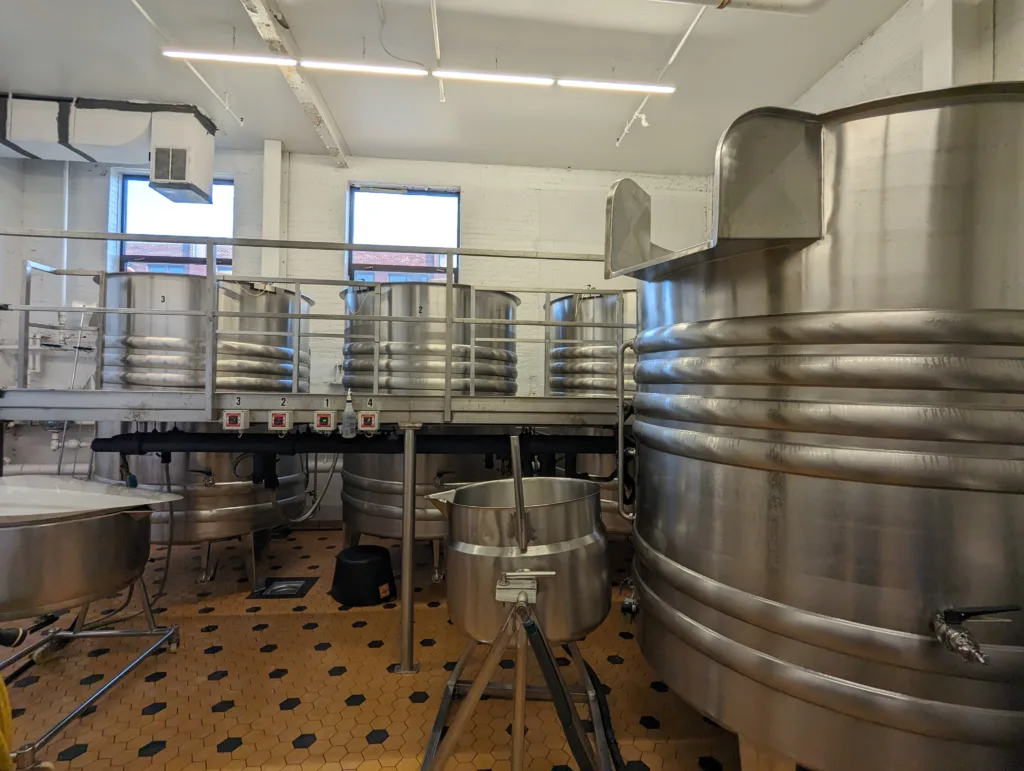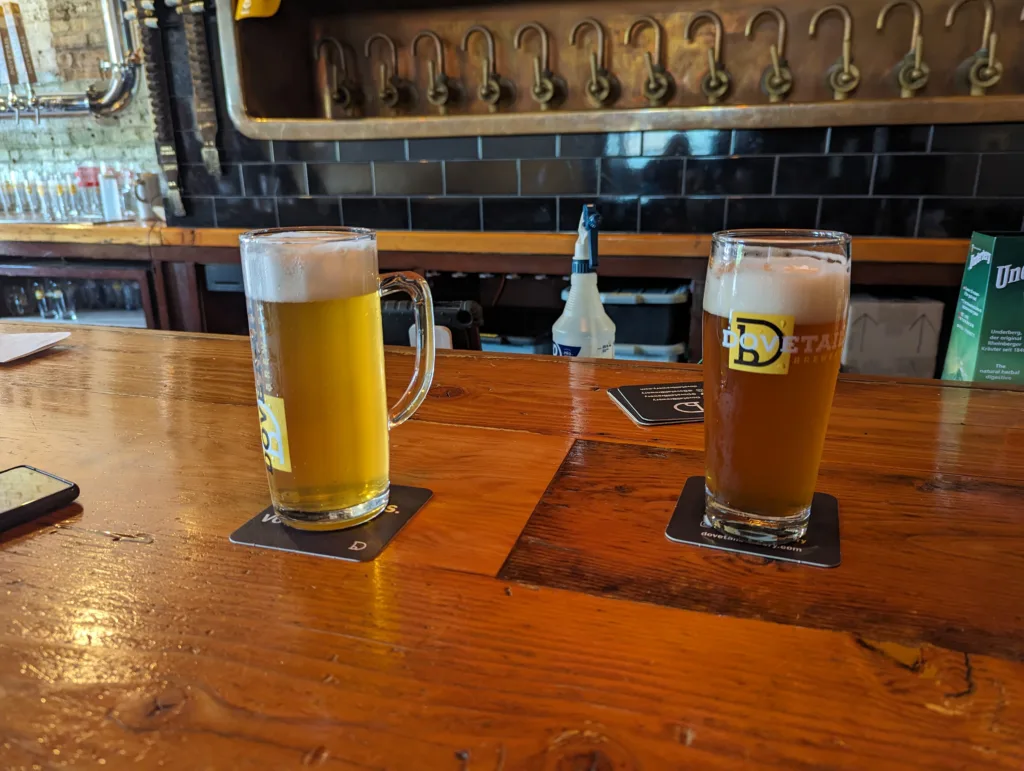My wife and I spent the first two weeks of June 2024 in the US for our holiday. I got this trip as a gift for my 40th birthday last year from my lovely wife (lucky me!): we started in Chicago, IL, then went to Austin, TX, and finished the trip with a few days in Boston, MA.
I could tell you all the details of my trip, and how absolutely amazing it was, but this is not a travel blog. I rather want to talk about beer. More specifically, about lager beer, because that’s what interests me, and that’s what I want to drink. So that’s what I did: lager beers of whatever style available was my first choice when ordering beer in the US. I had plenty of excellent ones, some good ones, some okay ones, and some bland and boring ones. So let me tell you about the outstanding ones, about 4 breweries that I was very much interested in from the start, and which did not disappoint. This is part 1 of a series of articles that I intend to publish in the next few weeks.
Dovetail (Chicago): Franconian at Heart
I had heard about Dovetail quite a few years ago, everyone I know who had visited there had told me that their beers were excellent, so naturally, I just had to go there as well. As I had previously communicated with them by email, I mentioned my intention to visit and say hello, and was invited for a tour around the brewery.
On our first full day in Chicago, our plan was to watch a baseball game (Cubs v Phillies) and then to visit the brewery for a few beers afterwards (Dovetail isn’t far away from Wrigley Field, the Cubs’ gorgeous historic stadium), which is exactly what we did. After ordering our beers (Vienna Lager for me, of course), we were greeted by Jenny Pfäfflin (one of Dovetail’s employees who I’ve known on social media for years) and Hagen Dost and Bill Wesselink, the brewery founders. We were chatting and trying out the beers. By coincidence, another group of people from Canada also visited the brewery to meet Hagen et al, so we also got to say hello to them. It was a pleasant surprise to discover Jordan St. John in the group, who I had followed online for years. The beer world seems so small when something like that happens.
We were eventually shown around by Hagen and Jenny in a private tour of the brewery. Dovetail’s brew kit is very German: a mash tun, a lauter tun, a kettle, and a holding vessel.

Following a rather traditional vibe, the brew kit is accompanied by a coolship located upstairs, into which wort is pumped after boiling and left to cool there until it’s dropped to 75°C (167F) after which it’s pumped through a plate chiller and into open fermenters (accomplishing the traditional vibe).
As Hagen had to leave but we had so much more to talk about, he invited me to come around another day for me to witness some of their brewing. And that was truly exciting: sure, I got to see somebody brewing on the kit, but most excitingly, I witnessed wort being cooled in the coolship!

In my conversation with Hagen, what became clear to me is how well he understands Bavarian and Franconian beer culture, and how much he’s done to discover some great breweries off the beaten path. He then showed us how a coolship was part of the plan when he was brewing with Bill before they had even founded Dovetail: on one side of the room, a small rectangular metal vat was leaning against the wall, which is what they used as a coolship when they still test-brewed on essentially home-brew scale.
But Dovetail isn’t just a German-style brewery: they will brew the classic Central European styles, whether they’re from Germany, Austria, Czechia or Poland, but also do spontaneously fermented beers in the style of Belgian Lambic (they don’t call it that, though). I didn’t try any of the sour beers, but I tried plenty of the others: Helles, Dunkles, Vienna Lager, Lager (their idea of a Franconian Landbier), Sticke (a slightly stronger Altbier), Kölsch, Rauchbier, and Grodziskie. Honestly, I couldn’t fault any of them.
The Vienna Lager is straight to the point: just Vienna malt and Styrian Golding hops. According to Jenny, they occasionally get people complaining how it’s not adherent to the BJCP style guidelines, and they’re right. But neither would have been historic Vienna Lager, and the BJCP is meant for competitions. Dovetail’s Vienna Lager has a certain minimalism about it that just makes it an easy-drinking, uncomplicated beer with the right amount of malt complexity to make it exciting and a beer I could’ve been drinking the whole afternoon/evening (if I hadn’t wanted to try many/most/all of their beers).
The Dunkles was equally good, and exactly what I’d expect in a Bavarian brewery. Hagen later told me it had been inspired by Kloster Weltenburg’s Dunkel. Their Lager was a kind of Helles, similar but different from their regular Helles, and definitely something I’d expect in a small Franconian brewery served as the #1 beer consumed in large quantities by most of the village. Sticke and Kölsch tasted like the Rhineland, the Rauchbier would probably be well-received in Bamberg (personally, it reminded me more of Spezial than of Schlenkerla), and the Grodziskie wasn’t very different from the one I tried a few months ago.
But most importantly, all of the beers had character. They weren’t just very good, clean examples of their respective styles, they all had something about them that made them truly exciting to drink. Some cleaner, some maybe a bit rustic, but all of them with something that just screamed “this is the style in which we brew our beers, and we like it like that” to me.
That’s when I realised that there is something very Franconian about Dovetail, not just in the aspects of traditional brewing (like the coolship and the open fermentation), but also the “house style” that goes into them. At the same time, Hagen is very technically minded: he spoke to me about how they are very specific about certain temperature rests during mashing, such as alpha amylase rest (a mash rest at a temperature range that promotes the activity of alpha amylase, an enzyme that chops down chains of starch first into unfermentable dextrines and if given enough time, eventually into some fermentable sugars), as there are other things happening at around 72°C, such as the extraction of glycoproteins, which are relevant for head retention. Hagen even specifically spoke about glycoprotein rest and how important it was for their Hefeweizen which they brewed that day.
(Back home in Germany, I looked up glycoproteins in brewing literature, and really, Prof. Narziss mentions it in a few sentences in his book)

Hagen also emphasised the importance of the coolship in removing DMS precursors from their wort. What I could contribute was to teach him the German term for that: “ausstinken” (lit. “to stink off”), and that it’s not only used to describe what happens in the coolship, but also in open fermentation, another traditional element Dovetail employs.
All in all, I was really happy with every single beer I drank at Dovetail. I also have to thank everyone at Dovetail, but especially Jenny, Hagen and Bill, for the friendly welcome we received. We actually brought a few cans of their Helles and their Vienna Lager back to Berlin, and they travelled quite well.
Thinking back, there is something quite special about a brewery like Dovetail, something that I wouldn’t be able to find the same way in Germany: I could go there to drink really well-brewed German, Czech, Polish styles, easily at the same level as a good, traditional brewery back in Europe. But unlike here, I could enjoy a whole range of local styles from all over Central Europe at the same time. I don’t know of any brewery that serves a Helles, a Kölsch, an Altbier, a Rauchbier, a Hefeweizen and a Grodziskie all at once, at an incredible quality.


